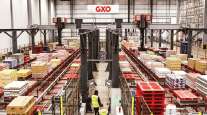Special to Transport Topics
Warehouses Look at Ways to Improve Recruitment, Retention

[Stay on top of transportation news: Get TTNews in your inbox.]
There’s no place to hide from the ongoing labor shortage in trucking, especially across the supply chain industry, which affects employment at warehousing, fulfillment and distribution centers. With the pandemic era’s spike in e-commerce coupled with the “great resignation,” greater efforts have been placed into recruitment and retention. Now, the use of automation in warehouses to streamline efficiencies, already part of the conversation pre-pandemic, has accelerated.
Sabrina Wnorowski, chief human resources officer at Radial Inc.,noted that a labor shortage can lead to further disruptions of the supply chain. “Distribution centers are central to the e-commerce ecosystem,” she said. “When faced with labor shortages, brands and retailers experience higher operating costs and disruptions in service delivery.”
John Williams, senior vice president-head of contract logistics for U.S. and Canada at Geodis, said having a right-sized labor profile is critical to meeting customer expectations and maintaining a healthy relationship.
“If you run into labor shortages in the warehouse environment, that means you are receiving more orders than you can fulfill, which may negatively impact [key performance indicators] or [service level agreements],” he noted. “If this is prolonged, that can ultimately damage the customer relationship.”
Turnover Rates
Most companies are experiencing a bit of recovery since the pandemic-influenced employee shortage. “Turnover has been steadily decreasing for the past few years,” said Wnorowski. “We attribute this decline to changing market conditions, an increased focus on converting part-time associates to full-time employees, and improved employee experience since the height of the pandemic.”

Geodis offers flexible and part-time opportunities, along with seasonal work, competitive pay and bonuses. (Geodis)
Geodis has also experienced a decrease in voluntary turnover rates over the past two years. Sarah Damschroder, vice president of human resources at Geodis in Americas, said that for the markets where there is new business or off-cycle peaks that don’t necessarily align with the traditional fourth-quarter timeline for retail, the trend indicates a lessened challenge with hiring in the warehouse environment.
“This can be attributed to a decrease in overall consumer demand, which helps alleviate the immediate need to onboard new workers,” she explained. “However, the dynamic nature of this industry requires a flexible workforce management strategy should the hiring landscape change quickly based on demand — as it often does.”
Another illustration is Ryder, which reported that employment for warehouse workers has grown 80%, from 6,265 in 2019 to 11,268 in March 2024, and its turnover rate is also below industry averages.
Compensation
Pay rates for warehouse workers are not rising as sharply as in recent years and are actually stabilizing in some markets, said Wnorowski. “However, we see prospective employees valuing their work experience as equally important as their wages,” she said.
Damschroder concurred that wage growth is leveling industrywide. In an industry where workers often move from job to job, this leveling has started to minimize the movement of workers, which has in turn improved retention across the supply chain, she explained.
But pointing to figures from the Bureau of Labor Statistics, Tom Fogerty, senior vice president of human resources at DHL Supply Chain, said that the average warehouse worker hourly wage increased from $20.33 at the beginning of 2019 to $24.70 in early 2024. “As the market has become more competitive and the skill levels of workers are increasing, so too have wages,” he said.
Recruitment
Recruitment efforts tend to parallel business needs, though sometimes the need elevates because of the season. Efforts are focused on digital job postings, utilizing such sites as Indeed and LinkedIn, but often, word-of-mouth from satisfied employees can be a strong recruiting tool, such as what Radial experiences. “We’ve also increased our focus on inclusion and equity to adapt to our diverse employee base. We have expanded our interpersonal and technology programs to be multilingual and a stronger reflection of our surrounding communities,” said Wnorowski.

Radial has increased its focus on inclusion and equity to adapt to its diverse employee base. (Radial)
Geodis utilizes digital tools to make it easier to navigate the website and the application process, such as using a virtual recruiting assistant, especially when recruiting in multiple languages.
Damschroder noted that their clients experience various levels of demand throughout the year and have operations across the world.
“These factors drive recruitment so we can be tailored to their needs. Of course, any time we expand, there is going to be a need for additional labor and support too,” she said. “With so many variables, labor forecasting is incredibly helpful in order to analyze our workforce both holistically and on a case-by-case basis.”
DHL Supply Chain launched a marketing and awareness campaign in 2022 that has improved their applicant process. Fogerty said that it is more important than ever to highlight the growth potential in the industry to potential new recruits. “By sharing insights about not only DHL Supply Chain but also highlighting supply chain as a career destination, we have seen double digit percentage increases in our applicant pipelines year-over-year,” he said, adding that part of these initiatives includes a college recruitment program.
The company also has shifted to a regional recruiting network with centers across the U.S. and Canada. Through open houses and targeted events, DHL is able to tap into these local labor markets.
Ryder has a multifaceted approach to attracting new employees. Lesley Kerr, vice president of human resources, explained that from social media to online job boards to local advertising, the fleet has reached a broad group of perspective employees. “We use as much video content as we can to show perspective employees what a day in the life at Ryder will be like,” she said.
Retention
Some companies have reported a greater focus on improving retention efforts. For example, Geodis also reported offering flexible and part-time opportunities, along with seasonal work, competitive pay and bonuses.
To retread or not to retread, that is the question. For some maintenance managers, the debate between purchasing new tires or retreads is constant. In this episode, host Michael Freeze finds answers about tires with Alex Aguilar, senior training specialist at Bridgestone Americas. Tune in above or by going to RoadSigns.ttnews.com.
Although Geodis is not experiencing an employee shortage that requires a change in strategies, the company nonetheless has developed engagement initiatives, like employee resource groups. The software firm uses a proactive approach to gathering feedback through “Let’s Talk,” a roundtable meeting within its warehouses led by HR with a small group of employees to provide a two-way communication forum, and “Talk5,” a program that ensures frontline leaders are engaging in one-on-one communication with their hourly teammates on a regular basis early in their careers. Other retention efforts are focused on anonymous pulse surveys to gather feedback regarding employee satisfaction and prioritizing professional development and personal well-being.
DHL also focuses on internal advancement, making sure employees have opportunities to grow within the company via training programs. “Offering competitive wages and benefits isn’t enough,” said Fogerty. “You need a culture where people feel they are valued and find a place where they belong.”
DHL also introduced a flexible scheduling tool to provide more flexibility with shifts for its warehouse employees.
Automation
Automation, which has been on the rise in warehouses and distribution centers, comes with many advantages from promoting efficiency to reducing human error and stress, freeing up time for employees to engage in other tasks.
It has also evolved from digital solutions, like warehouse management software that tracks inventory, as well as physical solutions, such as autonomous robots and automated retrieval systems.
“In some cases, this technology may help a worker travel less across the distribution center floor, while in other cases, it may provide better work instruction in their primary language,” added Wnorowski.
Automation not only improves speed, productivity and efficiency, it can directly affect retention. “When you integrate the right automation and robotics solutions into the warehouse, it can relieve workers of tedious repetitive tasks, which helps increase retention by making the job more enjoyable,” said Williams.
At another warehouse, the company uses AutoStore, which “serves as the fulfillment engine for almost all [stock-keeping units] except those that are too bulky or fragile to be handled by automation. From picking to packing to bagging, almost all inventory touches in this facility are automated. This facility fits our clients’ specific needs exceptionally well,” said Williams.

Fleet leaders note that as the market has become more competitive and the skill levels of workers are increasing, so too have wages. (DHL)
At DHL, 90% of the warehouses, globally, include some form of digitization solution, including autonomous mobile robots, which help alleviate physical strain and save time. Fogerty noted that while there are labor challenges, the industry isn’t at a point where it is impeding productivity. However, technology has been a key enabler in helping businesses to respond to the ebb and flow of demand.
“Where there are unplanned peaks, automated solutions like collaborative picking robots can quickly be brought online to meet those demands,” he said. “It is important to remember, however, that technology is not a replacement for people, which is why we continue to aggressively ramp up our recruitment and retention efforts.”
However, Fogerty explained, the most significant impact might be the shift in worker focus. By taking over the more mundane and repetitive tasks, automation frees human workers to take on more strategic roles.
Ryder’s investment in warehouse automation has increased 15-fold in the past five years, after having evaluated more than 250 solutions. Gary Allen, vice president of supply chain excellence, said that understanding how these technologies fit the profile of the business is critical to determine if these applications are ready now, while keeping an eye on what emerging technologies are coming in the future. “Examples include reducing operator travel time through goods-to-person automation solutions like autonomous mobile robots and automated storage retrieval systems,” he said. “This type of automation has resulted in two to four times productivity gains across Ryder’s warehouses.”
The Future
All experts believe that the supply chain industry will continue to grow, third-party logistics providers will see further growth, and automation will continue to evolve.
Fogerty said that work in DHL will likely look very different over the next several years as automation and technologies continue to evolve, but people will always be at the core of what they do.
“Talented skilled professionals like our commercial drivers will continue to be a vital link in the process. Frontline associates will become more system savvy and learn new roles supporting the technology they will utilize to perform their tasks,” he said. “We will continue to need strong leadership from the front line all the way through the C-level of our organization.”
Want more news? Listen to today's daily briefing above or go here for more info
Automation will continue to play a significant role in the future, with anticipation for more fully or semi-automated warehouses.
Allen contends that attracting and retaining warehouse employees will continue to be critical in the future, and the role of automation will continue to advance rapidly while offering more flexible, scalable and cost-effective solutions.
“This automation won’t eliminate all warehouse jobs in the future, but it will change the role of employees by making the job easier and shifting more toward value-added activities,” he said. “As companies strive toward building out world-class warehouses, automation and the use of data analytics will be a critical enabler.”





